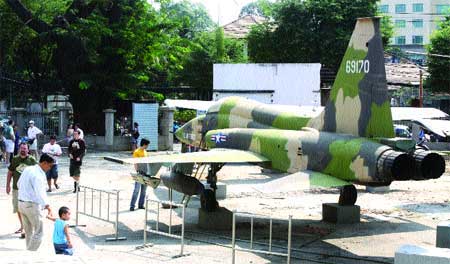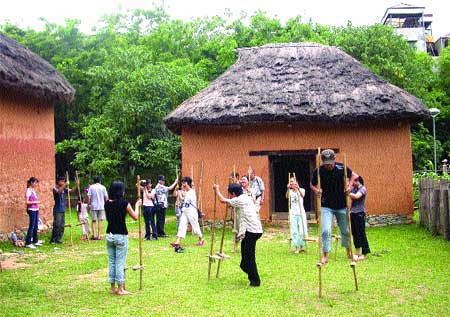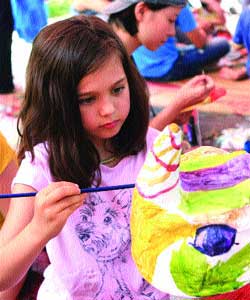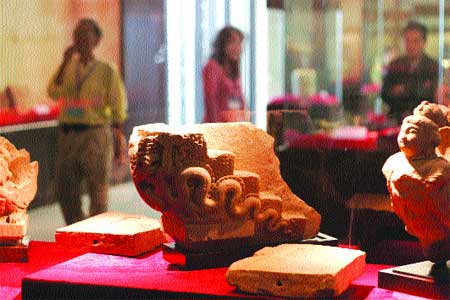|
Museums learn to
think outside the box
The
There in the museum they can also try
various kinds of foods eaten during the war years, liked baked sweet potatoes
for soldiers who went out to crawl among deadly munitions, or dried banana
skins - a rather unusual ‘specialty' consumed by revolutionary prisoners of
war.
Such aspects of the recent wars in
"We invited former prisoners to
come over and make dry provisions from banana peel, and one time guerrillas
to make pressed rice balls and baked fish," Huynh Ngoc Van, the director
of
The event of sharing food with the
veterans in a cosy fire-side chat is considered a unique specialty by the
museum. "While making food, these former soldiers also tell stories
about the miserably hard war days," she says.
This special event focusing on the
stories of soldiers' food has attracted a large number of foreign visitors to
the museum in order to experience what has been termed 'heritage tourism' - a
type of interactive exposition that many museums now offer.
"The museum's revolutionary war
banquet ended with no leftovers, and with 500 foreign visitors all left
feeling quite satisfied," Van adds proudly.
Growth of opportunities
There are 134 museums at national and
provincial level nationwide in
In direct relation to the fast
increase in the number of museums is the number of visitors, which
illustrates not only the popularity of the institutions but also highlights
how museums remain an important part of society, not only culturally but also
economically.
According to Nguyen Van Cuong, the
director of the Viet Nam National Museum of History, museums, together with
cultural and heritage tourism, contribute significantly to the tourism
industry. He believes the relationship between museums and tourism is a
strong and sustainable one.
"The museums and their artefacts
not only preserve the essence of the past, but also attract both domestic and
foreign visitors, contributing to the growing industry," he says.
He believes museums help to express
and maintain national pride in traditions, culture and history. According to
many tour agencies, museums and relics sites are considered the most
attractive destinations for tourists, especially foreign ones.
"Most domestic and foreign
travel agents have led their customers to the
"And many tourists have
confirmed that they have visited the museum more than once," she adds.
However, currently not all museums
and places displaying relics have been able to manage the demand on their
collections.
The Viet Nam National Museum of
History preserves the largest number of precious artefacts in the country,
over 200,000.
Even though the objects are
beautiful, the way of displaying them is still boring, so keeping the
exhibitions fresh and rotating the objects from the storages vaults to the
display room remains a challenge for their staff.
Then there are days when special
objects are displayed the halls are packed with crowds, further deterring
tour guides from leading their groups through the doors of the museum.
"That explains why many tour
guides hesitate to lead the tourists to the Viet Nam National Museum of
History," says Luu Duc Ke, the director of Hanoitourist Travel Company.
Despite these accolades the museums
and heritage tourism operators have not co-ordinated with one another in a
mutually beneficial way, so there remains a glaring opportunity left
unrealised.
Encouraging curiosity
Heritage tourism is gradually
becoming another string to
Ke agrees, adding: "
"After each tour, feedback is
sent to us, then the travel agents and museums will discuss this with each
other," Ke adds.
To turn museums into key destinations
on any travel itinerary - and importantly for tourists in general - it is
necessary to know the potential heritage treasure preserved within museums,
this includes renovating museum lay-outs, displays, content, as well as their
services.
Ha says the museums in
"The visitors come to the
museums not only to contemplate and study the exhibits but also to enjoy an
atmosphere with interesting information booths, souvenir shops or
restaurants. They will not consider trips to museums that may be a tedious
activity," he says.
But the most important factor is that
the museums have to possess a key point that can draw the attention of the
visitors, like a themed exhibition or collection.
For example, the
"In 2007, the Love During War
exhibition, brought in 160,000 visitors in over two months, and early this
year, the Children During War exhibition attracted 265,000 visitors after
five months," says war museum director, Van.
Curatorial guidance
Tour guides play an important role in
helping visitors to comprehend the museum's content and to get a more
thorough understanding of the cultural context that the artifacts come from.
Not only understanding their own history, culture and society, the guides
also have to be fluent in the foreign languages and confident at conversing
with a wide range of peoples.
This is why the Viet Nam National
Museum of History has paid special attention to the training of its curators.
So far 20 people have been selected from specialised universities to work in
the museum.
"When they start to work in
tourism, they will certainly have opportunities to widen their specific
knowledge through interacting with the working environment," says Cuong,
Another important aspect of spreading
information and popularising the museums is the use of the internet. The Viet
Nam National Museum of History website has had over 8 million hits.
The museum produces leaflets and
post-cards to show off its unique artefacts, like its collection of colourful
glaze porcelain, as well as publishing its own scientific research.
"In the years to come, the
museum will improve advertising, and will especially co-operate more closely
with top-notch Viet Nam travel agents to broadcast its image both on both the
domestic and international front," Cuong finishes.
He is confident that museums are
moving in a positive direction and are taking into account the needs of its
changing audience.
"The collaboration between
museums and heritage tourism is a sound direction for our development, it
confirms the role of the museums and works to achieve our goal of turning
them into desirable spots for visitors taking a journey to discover the
country's history and culture."
Source: VNS
|
Chủ Nhật, 20 tháng 10, 2013
Đăng ký:
Đăng Nhận xét (Atom)




Không có nhận xét nào:
Đăng nhận xét